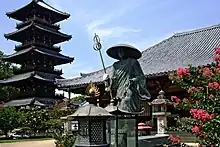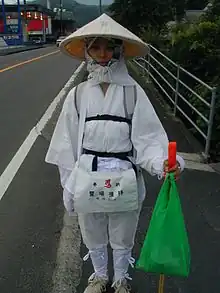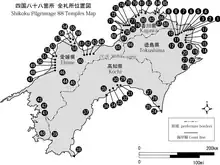88 Temple Pilgrimage
multi-site pilgrimage of 88 temples associated with the Buddhist monk Kūkai (Kōbō Daishi) on the island of Shikoku, Japan
The 88 Temple Pilgrimage (八十八ヶ所巡り hachijūhakkasho-meguri) is Japan's most famous pilgrimage route, a 1,200-km loop around the island of Shikoku.
Understand

Many of the temples are said to have been founded or restored by the revered monk and scholar Kūkai (空海), better known by his posthumous title Kōbō Daishi (弘法大師). Among his many achievements, he is said to have created the kana syllabary, brought the tantric teachings of Esoteric Buddhism from China, developed it into the uniquely Japanese Shingon sect, and founded Shingon's headquarters on Mount Koya near Osaka.
While most modern-day pilgrims (an estimated 100,000 yearly) travel by tour bus, a small minority still set out the old-fashioned way on foot, a journey which takes about six weeks to complete. Pilgrims, known as o-henro-san (お遍路さん), can be spotted in the temples and roadsides of Shikoku clad in a white jacket emblazoned with the characters Dōgyō Ninin (同行二人), meaning "two traveling together"—the other traveler being the spirit of Kobo Daishi.
Locals will be excited to see someone making the journey on foot, and priests will be relieved that you are not showing up with 100 of your close friends. Make sure that your Japanese is good enough to communicate your feelings to both groups!
Prepare

Completing the course the traditional way on foot is a serious undertaking that demands several weeks. Good physical fitness and stamina are required to endure the stress of constant walking up and down the hills of Shikoku, in the burning sun and the pouring rain.
Many pilgrims choose to dress up in traditional white attire:
- byakue – the white coat of a pilgrim
- wagesa – scarf worn around the neck, usually purple, to indicate that you are on a religious pilgrimage
- sugegasa – conical straw hat
- kongōtsue – walking stick, and the one indispensable sign that identifies you as a pilgrim
In addition, most pilgrims carry a book called nōkyōchō or shuincho, to collect a red ink stamp (shu-in) by each temple you visit, and hundreds of osame fuda (long slips of paper with your name and explanation of your pilgrimmage, to be left at each temple and given to each person who helps you; for your first trip, the paper should be white). All of these items can be purchased (in a formal sense) at Mount Koya or at Ryozenji, the first temple.
Many pilgrims who begin the pilgrimage on foot do not finish it. Many pilgrims also split up their trips over multiple years. It is common to hear of people giving up in Kochi, traditionally known as "devil's land" because of its hot temperature, intense rain, and infrequent contact with civilization. (This means you must either camp, sleep in a rest stop, or precisely time your journey to only hit towns and be willing to pay up for a hotel room.) Pilgrims who intend to walk the pilgrimage should ensure they have packed adequate supplies, such as rain gear, in addition to pilgrimage gear.
It is also important to factor costs. Costs include larger expenses, such as nightly lodging, as well as frequent smaller expenses, like the small charge at each temple to stamp your record book. Former pilgrims that have walked the Shikoku Pilgrimage have shared cost calculators:
Blog
- Grace, "Henro 2009" (2009). A walking pilgrim from Singapore
- Jasbir Sandhu, 「四国八十八ヶ所巡り」 (2011/2015) A walking pilgrim from India.
- Kat Davis, "Followingthearrows" (2013) A walking pilgrim from Australia.
- 澤村よし, "A pilgrimage trail to 88 temples in Shikoku, Japan" Useful information for pilgrimage, built by Japanese.
- Cheng Chen-Hsin, "Cycling in Shikoku Henro" (2015) A cycling pilgrim from Taiwan.
- Athena Lam, "The Cup and the Road" (2015) A walking pilgrim from Canada.
Get in
It is traditional to prepare by visiting Mount Koya, but the route itself starts at Ryōzenji, near Tokushima, and you have to return here in order to complete your pilgrimage. It is not necessary to start at temple #1 as long as you visit them all, but this is by far the most popular starting point for pilgrims from outside Shikoku, because it is also the closest to people coming from Mt. Koya.
The temples are usually visited in clockwise order, although this too, is just a convention—in practice, as all signs are oriented for pilgrims going clockwise, it's easier to get lost if you try to go against the flow.
Go

Most pilgrims walking on foot average around 25 km daily and complete the trip in five to seven weeks.
The canonical list of temples is as follows:
| No. | Temple | City | Prefecture | Notes |
|---|---|---|---|---|
| 1 | Ryōzenji (霊山寺) | Naruto | Tokushima | |
| 2 | Gokurakuji (極楽寺) | Naruto | Tokushima | |
| 3 | Konsenji (金泉寺) | Itano | Tokushima | |
| 4 | Dainichiji (大日寺) | Itano | Tokushima | |
| 5 | Jizōji (地蔵寺) | Itano | Tokushima | |
| 6 | Anrakuji (安楽寺) | Kamiita | Tokushima | |
| 7 | Jūrakuji (十楽寺) | Awa | Tokushima | |
| 8 | Kumataniji (熊谷寺) | Awa | Tokushima | |
| 9 | Hōrinji (法輪寺) | Awa | Tokushima | |
| 10 | Kirihataji (切幡寺) | Awa | Tokushima | |
| 11 | Fujiidera (藤井寺) | Yoshinogawa | Tokushima | |
| 12 | Shōzanji (焼山寺) | Kamiyama | Tokushima | The climb from 11 to 12 is notoriously tough! |
| 13 | Dainichiji (大日寺) | Tokushima | Tokushima | |
| 14 | Jōrakuji (常楽寺) | Tokushima | Tokushima | |
| 15 | Kokubunji (国分寺) | Tokushima | Tokushima | |
| 16 | Kan'onji (観音寺) | Tokushima | Tokushima | |
| 17 | Idoji (井戸寺) | Tokushima | Tokushima | |
| 18 | Onzanji (恩山寺) | Komatsushima | Tokushima | |
| 19 | Tatsueji (立江寺) | Komatsushima | Tokushima | |
| 20 | Kakurinji (鶴林寺) | Katsuura | Tokushima | |
| 21 | Tairyūji (太竜寺) | Anan | Tokushima | Tough mountain temple |
| 22 | Byōdōji (平等寺) | Anan | Tokushima | Another tough mountain temple |
| 23 | Yakuōji (薬王寺) | Minami | Tokushima | |
| 24 | Hotsumisakiji (最御崎寺) | Muroto | Kochi | |
| 25 | Shinshōji (津照寺) | Muroto | Kochi | |
| 26 | Kongōchōji (金剛頂寺) | Muroto | Kochi | |
| 27 | Kōnomineji (神峰寺) | Yasuda | Kochi | |
| 28 | Dainichiji (大日寺) | Konan | Kochi | |
| 29 | Kokubunji (国分寺) | Nankoku | Kochi | |
| 30 | Zenrakuji (善楽寺) | Kochi | Kochi | |
| 31 | Chikurinji (竹林寺) | Kochi | Kochi | Superb views over Kochi city from the park just west of the temple |
| 32 | Zenjibuji (禅師峰寺) | Nankoku | Kochi | |
| 33 | Sekkeiji (雪蹊寺) | Kochi | Kochi | |
| 34 | Tanemaji (種間寺) | Haruno | Kochi | |
| 35 | Kiyotakiji (清滝寺) | Tosa | Kochi | |
| 36 | Shōryūji (青竜寺) | Tosa | Kochi | |
| 37 | Iwamotoji (岩本寺) | Shimanto | Kochi | |
| 38 | Kongōfukuji (金剛福寺) | Tosashimizu | Kochi | |
| 39 | Enkōji (延光寺) | Sukumo | Kochi | |
| 40 | Kanjizaiji (観自在寺) | Ainan | Ehime | |
| 41 | Ryūkōji (竜光寺) | Uwajima | Ehime | |
| 42 | Butsumokuji (佛木寺) | Uwajima | Ehime | |
| 43 | Meisekiji (明石寺) | Seiyo | Ehime | |
| 44 | Daihōji (大宝寺) | Kumakogen | Ehime | |
| 45 | Iwayaji (岩屋寺) | Kumakogen | Ehime | |
| 46 | Jōruriji (浄瑠璃寺) | Matsuyama | Ehime | |
| 47 | Yasakaji (八坂寺) | Matsuyama | Ehime | |
| 48 | Sairinji (西林寺) | Matsuyama | Ehime | |
| 49 | Jōdoji (浄土寺) | Matsuyama | Ehime | |
| 50 | Hantaji (繁多寺) | Matsuyama | Ehime | |
| 51 | Ishiteji (石手寺) | Matsuyama | Ehime | |
| 52 | Taizanji (太山寺) | Matsuyama | Ehime | |
| 53 | Enmyōji (円明寺) | Matsuyama | Ehime | |
| 54 | Emmeiji (延命寺) | Imabari | Ehime | |
| 55 | Nankōbō (南光坊) | Imabari | Ehime | |
| 56 | Taisanji (泰山寺) | Imabari | Ehime | |
| 57 | Eifukuji (栄福寺) | Imabari | Ehime | |
| 58 | Sen'yūji (仙遊寺) | Imabari | Ehime | |
| 59 | Kokubunji (国分寺) | Imabari | Ehime | |
| 60 | Yokomineji (横峰寺) | Saijo | Ehime | |
| 61 | Kōonji (香園寺) | Saijo | Ehime | |
| 62 | Hōjuji (宝寿寺) | Saijo | Ehime | |
| 63 | Kichijōji (吉祥寺) | Saijo | Ehime | |
| 64 | Maegamiji (前神寺) | Saijo | Ehime | |
| 65 | Sankakuji (三角寺) | Shikokuchuo | Ehime | |
| 66 | Unpenji (雲辺寺) | Miyoshi | Tokushima | |
| 67 | Daikōji (大興寺) | Mitoyo | Kagawa | |
| 68 | Jinnein (神恵院) | Kanonji | Kagawa | |
| 69 | Kan'onji (観音寺) | Kanonji | Kagawa | |
| 70 | Motoyamaji (本山寺) | Mitoyo | Kagawa | |
| 71 | Iyadaniji (弥谷寺) | Mitoyo | Kagawa | |
| 72 | Mandaraji (曼荼羅寺) | Zentsuji | Kagawa | |
| 73 | Shusshakaji (出釈迦寺) | Zentsuji | Kagawa | |
| 74 | Kōyamaji (甲山寺) | Zentsuji | Kagawa | |
| 75 | Zentsūji (善通寺) | Zentsuji | Kagawa | |
| 76 | Konzōji (金倉寺) | Zentsuji | Kagawa | |
| 77 | Dōryūji (道隆寺) | Tadotsu | Kagawa | |
| 78 | Gōshōji (郷照寺) | Utazu | Kagawa | |
| 79 | Tennōji (天皇寺) | Sakaide | Kagawa | |
| 80 | Kokubunji (国分寺) | Takamatsu | Kagawa | |
| 81 | Shiromineji (白峯寺) | Sakaide | Kagawa | |
| 82 | Negoroji (根香寺) | Takamatsu | Kagawa | |
| 83 | Ichinomiyaji (一宮寺) | Takamatsu | Kagawa | |
| 84 | Yashimaji (屋島寺) | Takamatsu | Kagawa | |
| 85 | Yakuriji (八栗寺) | Takamatsu | Kagawa | |
| 86 | Shidoji (志度寺) | Sanuki | Kagawa | |
| 87 | Nagaoji (長尾寺) | Sanuki | Kagawa | |
| 88 | Ōkuboji (大窪寺) | Sanuki | Kagawa |
There are also 20 optional "unnumbered" (番外 bangai) temples.
Sleep
- There are many small inns that cater to pilgrims traveling either by foot or car. They typically cost between ¥4000-7000 per night, including dinner.
- Most temples provide lodging for henro, but it can be quite expensive (around ¥8000 per night is average).
- "Henro houses" are run by families or local businesses, and offer rooms (and sometimes food) to walking henro for a very small fee—or sometimes for free.
- There are also small free lodgings called zenkonyado and tsuyado that lodge travelers for the night, although these lodgings can be somewhat poor quality and have very limited facilities. (There is a zenkonyado near Zentsuji which is said to be haunted.) These were once the primary lodgings for walking henro; however, the island's culture has changed in the last 50 years, and the number of these lodgings have been reduced to just a handful.
Blogs listing cheap or free pilgrim accommodation:
Stay safe
Traveling in Shikoku is very safe, especially when you wear the traditional henro robes. People will be very helpful if they recognize you as a pilgrim, and will try to participate in your journey by giving you small gifts (osettai), which you must always accept.
The weather can be perilous at times; even during the optimal seasons of spring and fall, it may rain for days—particularly in the south. Proper preparation and staying up to date with weather reports is a must. You are, however, never far from civilization in case of emergency.
Be careful while walking in Kochi Prefecture, as it is the least populated. The major towns are far apart, and the coast is lined with small fishing towns that tend to shut down by eight or nine in the evening, making it difficult to find accommodations.
Shikoku is home to many snakes, including deadly pit vipers. When walking through brush or grass, stomping or otherwise making noise will divert most snakes from your path.
July and August are very hot, and attempting to walk the pilgrimage at the peak of summer is asking for a bad case of heatstroke. But for the brave, it can mean small crowds and almost guaranteed space at the henro houses. April and October are the best times to go, though accommodations will be particularly crowded.
Go next
In one tradition you aren't done when you reach the 88th temple—some believe you still have to trek back to the 1st to complete your pilgrimage! Another tradition suggests that closing the circle is not necessary and it is better to leave it open ended. However it is more common nowadays to return to the 1st temple.
Also if you've made it this far, it's only good manners to return to Mount Koya to give your thanks to Kobo Daishi.
Other pilgrimage routes in Japan
- Chugoku 33 Kannon Temple Pilgrimage - If you have the energy, you can easily begin this pilgrimage right after the Shikoku pilgrimage
- Narrow Road to the Deep North - Trace the steps of the famous poet Matsuo Basho